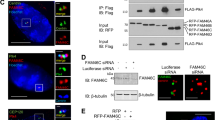Abstract.
The proto-oncogene pim-1 is a serine/threonine kinase the over-expression of which promotes lymphoma formation. Neither the normal function of Pim-1 nor the biochemical mechanism for cancer development mediated by the gene has been delineated, although recent studies have provided compelling evidence that Pim-1 is involved in differentiation and cell survival. We now provide the first evidence that Pim-1 may be involved in the proliferative process. By confocal microscopy, we observed a dynamic redistribution of Pim-1 during the cell cycle, the protein moving from the nucleus and cytoplasm in interphase to the spindle poles during mitosis. From a computer search for putative substrates of Pim-1 that are located in the spindle poles, we discovered that the nuclear mitotic apparatus (NuMA) protein has two peptide sequences that contain preferred phosphorylation sites for Pim-1 kinase. Recombinant glutathione-S-transferase-Pim-1 also readily phosphorylates immunoprecipitated NuMA. By confocal microscopy and co-immunoprecipitation we showed the interaction of the Pim-1 and NuMA proteins in HeLa cells that had been arrested during mitosis with nocodazole. Pim-1 also appeared to interact with heterochromatin-associated protein 1β (HP1β) and the cytoplasmic proteins dynein and dynactin via complex formation with NuMA. In our studies, overexpressed wild-type-Pim-1-GFP (green fluorescent protein) fusion protein was found to co-localize in the spindle pole with NuMA during mitosis. In contrast, the 'kinase-dead' mut-Pim-1-GFP fusion protein did not co-localize with NuMA, and appeared to promote apoptosis. Further evidence for apoptotic cell death was the observed blebbing and fragmentation of the chromosomes and a decrease in the level of NuMA protein detected by confocal microscopy. These results strongly suggest that Pim-1 kinase plays a role, most likely by phosphorylation, in promoting complex formation between NuMA, HP1β, dynein and dynactin, a complex that is necessary for mitosis.
Similar content being viewed by others
Author information
Authors and Affiliations
Additional information
Electronic Publication
Rights and permissions
About this article
Cite this article
Bhattacharya, N., Wang, Z., Davitt, C. et al. Pim-1 associates with protein complexes necessary for mitosis. Chromosoma 111, 80–95 (2002). https://doi.org/10.1007/s00412-002-0192-6
Received:
Revised:
Accepted:
Issue Date:
DOI: https://doi.org/10.1007/s00412-002-0192-6




